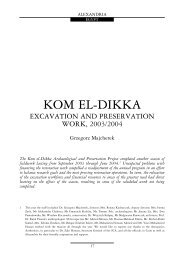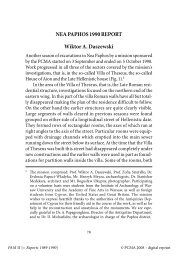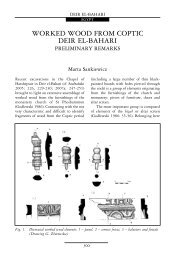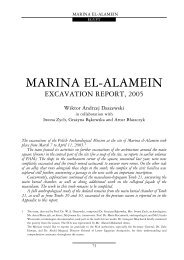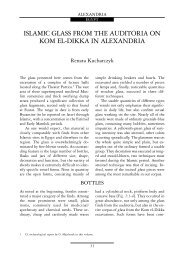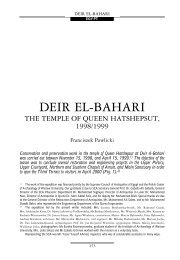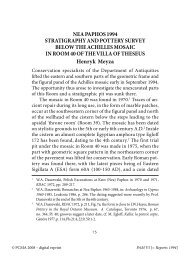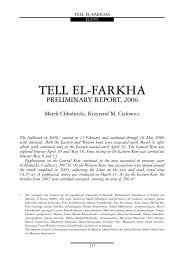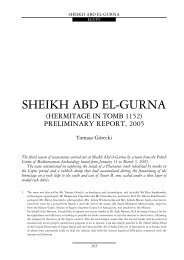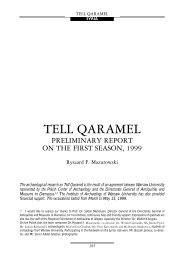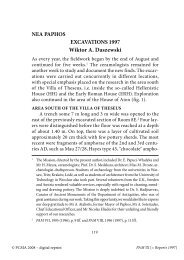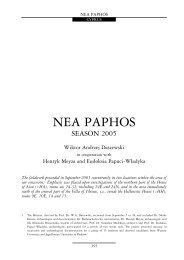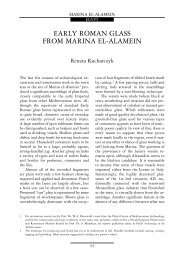ksiazka Tell Atrib:Layout 1.qxd
ksiazka Tell Atrib:Layout 1.qxd
ksiazka Tell Atrib:Layout 1.qxd
You also want an ePaper? Increase the reach of your titles
YUMPU automatically turns print PDFs into web optimized ePapers that Google loves.
<strong>ksiazka</strong> <strong>Tell</strong> <strong>Atrib</strong>:<strong>Layout</strong> 1 2007-09-19 10:55 Page 139<br />
<strong>Tell</strong> <strong>Atrib</strong><br />
emphasizing different aspects of the youthful<br />
son of Osiris, a resurrection symbol with evident<br />
political connotations, recalling Horus’<br />
identification with the ruling king. Not surprisingly<br />
some of the male terracotta figures<br />
reveal a physiognomy recalling portraits of<br />
the Ptolemies, while images of female<br />
deities feature typical elements from the<br />
iconography of queens from the court in<br />
Alexandria.<br />
Among the ample finds of terracotta<br />
figurines there are some that merit particular<br />
attention, finding no parallels as yet<br />
in the iconographic material from the territory<br />
of Egypt. One Harpocrates figurine demonstrates<br />
Asiatic facial features and Persian<br />
dress; a whole hand inserted in the mouth<br />
alludes to the motif of a finger touching<br />
the mouth, which was a typical element of<br />
the iconography of the youthful god.<br />
Another terracotta depicts him as an effeminate<br />
youth lying in a provocative pose, which<br />
can be considered a distant echo of the legend<br />
about Seth raping Horus, present in<br />
Egyptian literature from the Pyramid Texts<br />
on. Some of the figurines are veritable masterpieces<br />
in miniature, copies or imitations<br />
of the great artworks of Hellenistic stone<br />
statuary. One example is a tiny head, modeled<br />
in clay but left unfired, depicting a<br />
drunken old woman with dramatically contorted<br />
features. Many of the male faces present<br />
portrait characteristics; some are figures<br />
known from New Attic comedy, some representations<br />
of foreigners, Persians for example,<br />
dressed in their characteristic caps.<br />
One of the local workshops from<br />
the end of the 3rd century BC belonged to<br />
an artist of Greek origin, specializing in<br />
sculpting statues of Aphrodite in imported<br />
marble. Some fragments of such statues<br />
were found in a cache, the most exceptional<br />
piece being a figure with preserved polychromy:<br />
red on the goddess’ hair and<br />
blue on the robe. Further testimony of the<br />
work of a sculptor’s workshop from the<br />
early Ptolemaic period is a small portrait<br />
head of Ptolemy II Philadelphos, made of<br />
Egyptian limestone, doubtless a model for<br />
a statue of larger size.<br />
The workshop district extended to<br />
the south of a sizable building of red brick<br />
that was erected most likely in the times<br />
of Ptolemy VI. It was a public bath, furnished<br />
with small pools of different shapes.<br />
Between two wings of bath halls following<br />
an L-shaped plan there was a separate<br />
room with exceptionally thick walls. These<br />
were thickly plastered on the inside and<br />
outside, shaped and painted as polychrome<br />
panels. The interior of this room,<br />
as well as the immediate vicinity, contained<br />
the biggest concentration of vessels of<br />
a ritual character, used for holding either<br />
wine for drinking or oils for anointing the<br />
body. Many of these were richly painted<br />
or featured appliqué and stamped decoration;<br />
among the most frequent motifs were<br />
erotic scenes of couples engaging in sexual<br />
intercourse. Globular bowls with relief<br />
decoration stamped on the surface constituted<br />
a separate and special category of<br />
these ritual vessels. Some show a Greek-<br />
Egyptian divine triad (Isis, Sarapis, Harpokrates),<br />
others carry ritual representations,<br />
like, for example, cattle being led toward<br />
an altar on which a fire is burning and a cart<br />
transporting a bark with shrine for the<br />
god’s statue. Nor is there a lack of ceramics<br />
imported from different regions of the<br />
Hellenistic world and their local imitations.<br />
The architecture of the baths at Athribis<br />
and the objects found in the ruins indicate<br />
beyond all doubt that the facility was<br />
139



